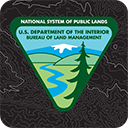This month, the BLM celebrates the spirit of the Wilderness Act
By Derrick Henry, Public Affairs Specialist
One bright summer morning in north-central New Mexico, as voices advertised their presence, dozens of people walked along a blazed path that started as warm-season grass and then descended through low trees, pools of sunlight and weathered rock. Their conversations faded at the end of the path, where a ledge revealed broad canyonland and more landscape sharpening in the distance. The group was admiring the Bureau of Land Management’s (BLM) new addition to the Sabinoso Wilderness, a donation accepted under the authority of the Wilderness Act, whose spirit we are celebrating this September during National Wilderness Month.
The potential for wilderness preservation was made early in the history of the public lands. In 1926 Robert Yard, one of the founding members of the Wilderness Society, wrote about what would become the BLM-managed lands, “In the public lands will be found wilderness regions of charm and beauty.” But when the Wilderness Act passed in 1964, the nation had not yet determined whether to keep the public lands administered by the BLM, much less to preserve a part of them as wilderness.
That changed in 1976 when Congress made the BLM the fourth federal agency to be responsible for managing wilderness. This was through a section of the Federal Land Policy and Management Act, or FLPMA. With that, the BLM joined the National Park Service, the U.S. Fish and Wildlife Service, and the U.S. Forest Service in preserving wilderness character for present and future generations. Two years later Congress designated the first BLM wilderness lands with the Wild Rogue Wilderness in Oregon, and the Santa Lucia Wilderness in California.
Since then, the BLM has played a unique role in wilderness preservation.
As most of its 260 wilderness areas exist in a wide variety of desert environments, the 9.9 million acres of BLM wilderness areas add an essential network of desert ecosystems to the National Wilderness Preservation System that was established under the Wilderness Act. With the other agencies combined, the National Wilderness Preservation System includes more than 800 wilderness areas spanning more than 111 million acres.
Millions of people visit these areas annually, either on their own or through the hundreds of permitted commercial outfitters that assist the public in enjoying these unique lands. Visitors provide significant social and economic benefit to local communities with nearby wilderness and help them to sustain their unique quality of life, which is so closely linked to the history and natural heritage of the wilderness landscapes. These places also became shock absorbers during the COVID-19 pandemic, when many Americans turned to these areas for physical recreation, mental well-being, and inspiration, and our public lands and waters became places of healing and sanctuary.
And perhaps even more importantly, wilderness protects vestiges of primeval lands in an untrammeled, natural, and undeveloped condition providing precious habitat for wildlife, clean air and water, and protection of unique plants.
BLM wilderness opportunities exist in places like the Black Rock Desert Wilderness in Nevada and the Eagletail Mountains Wilderness in Arizona. Both areas offer huge, vivid landscapes that invite exploration. In northwest Oregon, the Table Rock Wilderness contains a system of trails that gives visitors an opportunity to see the last chunk of ancient forest land in the Molalla River drainage. And in California, the Kingston Range Wilderness features unique wetland habitats, exceptional biological diversity, and is an ecological transition zone between the Great Basin and Mojave Desert. It’s a good place for kids of all ages to improve their understanding of Earth science.
At the heart of it all is the Wilderness Act of 1964, which enables the BLM to include wilderness preservation in its mandate to manage public land for multiple uses. The Wilderness Act also helps the BLM support the Administration’s historic “America the Beautiful” initiative, which sets a national conservation goal to invest in, conserve, connect, and restore at least 30 percent of the Nation’s lands and waters by 2030.
That initiative took a big step forward this past July 17 at the Sabinoso Wilderness in New Mexico, when Secretary of the Interior Deb Haaland, on behalf of the BLM, announced the acceptance of a donation of 9,617 acres from The Trust for Public Land, which brought the acreage to 29,242 acres, a nearly 50 percent increase. It was the largest expansion of a wilderness by means of donation in the history of the Wilderness Act. People at the dedication witnessed the shadows of passing clouds fold unfold and refold along the sides of the canyon. Piñon pine, ponderosa pine and juniper woodlands along the slopes gave way to riparian vegetation that hemmed in the bottom. The group commented on the striking contrast between the canyon before them, and the grass savanna just a few hundred feet behind them.
Wilderness areas are self-willed lands, both philosophically and in terms of how they are managed. In these places, you experience wild scenic beauty on your time, knowing that you can choose to do it now or later. As a result, these truly wild places are an important part of American identity.
This National Wilderness Month, we encourage all Americans to experience our Nation’s outdoor heritage, to recreate responsibly and to leave no trace, to celebrate the value of preserving an enduring resource of wilderness, and to reinforce our commitment to protecting these vital lands and waters now and for future generations. This is a time to strengthen connections to our wilderness areas, support their designation and protection, and work to preserve the stories they tell, the memories they create, and the heritage they reflect for all Americans for generations to come.
